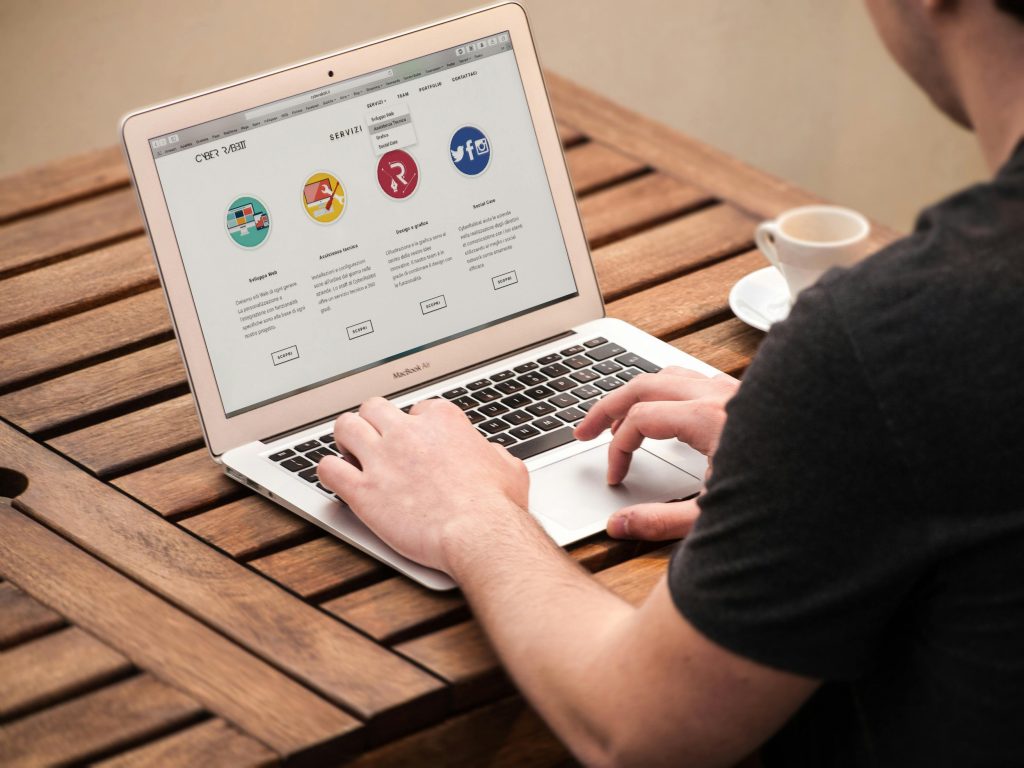Creating a website can feel overwhelming if you’re new to the process. Whether you’re building a personal blog, a business site, or an online store, having a clear step-by-step plan can make the entire process easier and more successful.
In this article, we’ll walk you through the full web design process, from the first idea to the final launch. You’ll learn how to plan, design, build, and maintain a site that not only looks good but also works well for visitors.
1. Understand the Purpose of the Website
Before you start designing, it’s important to understand why you’re building the website. Clarifying the purpose will guide every design and content decision you make. Ask yourself the following questions:
- Is this site for a business, a personal blog, a nonprofit, or a portfolio?
- What action do you want visitors to take—make a purchase, book an appointment, sign up for a newsletter, or simply read content?
- Who is your target audience? Are they professionals, students, parents, or another group?
Knowing the goal of your website helps set a clear direction. It ensures that the layout, colors, and features support the message you want to send.
Tip: Write a one-sentence mission statement for your website. For example, “This site helps small businesses find affordable web design solutions.” Keep this in mind as you plan and build.
2. Research & Inspiration
Once you’ve defined your website’s purpose, the next step is gathering ideas and inspiration. This helps you identify what works well and what you want your site to look and feel like. Start by browsing websites in your niche or industry. Pay attention to design elements that stand out or make the site easy to use.
What to look for:
- Color schemes and layout structure
- Font styles and text size
- Types of content used (like blog posts, videos, or product pages)
- How the navigation menu is organized
- Page loading speed and how the site looks on mobile devices
Take notes on what you like—and what you don’t. Creating a mood board or Pinterest board is a great way to collect your favorite design features in one place. These visual references will help guide your own creative decisions and keep your design focused.
3. Plan the Structure (Site Map)
Before jumping into design, it’s important to map out the structure of your website. A site map is a simple outline that shows all the pages your site will include and how they’re connected. This helps you stay organized, ensures you don’t forget any important pages, and makes it easier to design logical navigation.
Example of a Basic Site Map:
- Home
- About
- Services or Products
- Blog or Resources
- Contact
If your website has more depth, you can add subpages beneath main categories. For example:
- About
- Team
- Our Story - Services
- Pricing
- FAQs
Planning your site map in advance helps you structure your content clearly and improves the user experience. Visitors will be able to find what they’re looking for more easily, and your site will feel more professional and well-thought-out.
4. Create Wireframes
A wireframe is a simple layout that outlines the structure of each web page before you add colors, images, or detailed content. It’s like a blueprint or floor plan for your website, showing where elements like headers, text blocks, buttons, menus, and images will go.
Wireframes help you:
- Avoid clutter by giving each element a clear space
- Focus on user flow to guide visitors smoothly through the page
- Prioritize important content like calls to action and key messages
You don’t need to be a designer to build wireframes. You can sketch them on paper or use free and paid digital tools like:
- Figma
- Adobe XD
- Sketch
Wireframes let you experiment with layout ideas before committing to a design. This step saves time later by helping you avoid constant revisions once you start building the actual site.
5. Choose the Right Platform
Once your site structure and wireframes are in place, it’s time to pick a platform to build your website. The right platform depends on your experience, budget, and what kind of site you’re creating.
Popular Platforms:
- WordPress: Best for blogs, business sites, or custom functionality. It’s flexible and supports thousands of plugins. Requires some learning but offers great long-term control.
- Wix or Squarespace: Beginner-friendly with drag-and-drop tools. Ideal for simple websites, portfolios, or service-based businesses. No coding needed.
- Shopify: Designed specifically for e-commerce. Great for selling products online, with built-in tools for payments, shipping, and inventory.
- Webflow: Perfect if you want advanced design control without full coding. Good for designers and developers who want flexibility.
Tip: Try free trials if you’re unsure. Choose a platform that matches your technical comfort level, future plans, and the type of content you’ll manage.
6. Design the Website
With your platform selected, it’s time to start designing the actual pages. This is where your ideas, wireframes, and branding all come together. A clean and user-friendly design helps visitors navigate easily and take action.
Design Tips:
- Stick to 2–3 main colors that match your brand and are easy on the eyes.
- Choose legible fonts and limit it to one for headings and one for body text.
- Use white space to give your design room to breathe—don’t overcrowd the page.
- Make buttons and calls to action (like “Contact Us” or “Buy Now”) stand out with bold colors or shapes.
- Design for mobile first—most users will visit your site on their phone.
Don’t forget: Include essential pages like a homepage, about page, service/product pages, blog (if needed), and a contact form. A good design supports your site’s purpose and improves user experience.
7. Add Content
Once your design is in place, it’s time to fill your website with meaningful content. Great content tells your story, explains your services, and guides visitors to take action. Every word, image, and video should serve a purpose and match the tone of your brand.
Content Essentials:
- Headlines that are short, clear, and attention-grabbing.
- Simple paragraphs that explain your message without confusing jargon.
- Call-to-action (CTA) buttons such as “Buy Now,” “Get a Free Quote,” or “Contact Us” to guide users toward the next step.
- High-quality images that are relevant to your business and help break up long blocks of text.
- Alt text for all images, which improves accessibility for screen readers and boosts SEO.
Whether you’re writing a blog post or a product description, keep it clear, helpful, and focused on what your audience needs.
8. Develop the Site
Now that your design and content are ready, it’s time to build your website. If you’re using a website builder like Wix, Squarespace, or WordPress, this step may be as simple as dragging and dropping elements into place. If you’re working with a developer or using custom code, development will involve writing HTML, CSS, and JavaScript to bring your design to life.
No matter which method you use, development is when your website becomes functional.
Don’t Forget:
- Set up your domain name and hosting provider so people can find your site online.
- Install tracking tools like Google Analytics to monitor visitor activity and performance.
- Make sure your site is mobile-friendly, since many users will access it on phones or tablets.
- Test each page and link to catch broken elements, slow load times, or layout issues.
Thorough testing ensures a smooth, professional user experience.
9. Test Before Launch
Before launching your website to the public, it’s important to test everything carefully. This step helps you catch errors, fix problems, and make sure your site is ready for visitors. A well-tested site offers a better user experience and gives a more professional impression.
What to Check:
- All links should work properly and lead to the correct pages.
- Page speed should be fast on both desktop and mobile.
- Responsive design: Make sure your site looks good and functions correctly on phones, tablets, and computers.
- Contact forms: Test each form to ensure messages are sent to the correct email address.
- Navigation: Buttons and menus should be easy to use and clearly labeled.
Ask a few friends, family members, or coworkers to review the site. They might catch broken links, spelling errors, or layout issues you didn’t notice. Fresh feedback can be a huge help before launch.
10. Launch Your Website
After testing, it’s time to publish! Announce the launch on social media, email newsletters, or word of mouth.
But your job doesn’t end here…
11. Maintain and Update Regularly
Launching your website isn’t the final step—it’s just the beginning. To keep your site running smoothly and looking professional, regular maintenance is essential. A well-maintained website performs better in search engines, keeps users engaged, and protects against security issues.
Regular Maintenance Tasks:
- Update software or plugins to patch security holes and improve functionality.
- Add new blog posts or content to keep your site fresh and relevant.
- Fix broken links and remove or revise outdated information.
- Check site speed and performance regularly to ensure fast load times.
- Back up your site so you don’t lose important data in case of a crash.
Set a schedule to review your website at least once a month. Even small updates—like changing images or refreshing copy—can make a big difference in user experience and SEO rankings. A well-maintained site builds trust and keeps people coming back.
12. Track Your Results
Use tools like Google Analytics or built-in website reports to see:
- How many visitors come to your site
- Which pages get the most views
- What users click or do on your site
This helps you make smart changes to improve your website over time.
Bonus Tip: Work with Professionals if Needed
If the web design process feels too complex, consider hiring:
- A web designer for custom layout and branding
- A copywriter to write clear and helpful text
- An SEO expert to help your site appear on search engines
You don’t have to do it all alone.
Final Thoughts
The web design process is more than just choosing colors and fonts—it’s about planning, creating, and improving a website that truly serves your needs. By following these steps, you can build a site that looks great, functions well, and helps you meet your goals.
From planning your site map to testing for launch, each stage plays a vital role. Whether you’re using a DIY builder or working with a team, this guide helps you stay on track.
Ready to get started? Grab a notebook, outline your ideas, and take it one step at a time. A well-designed website is closer than you think.


